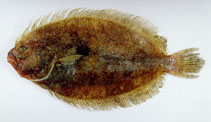http://www.fishbase.org/Summary/speciesSummary.php?genusname=Pseudorhombus&speciesname=javanicus ---> http://192.134.151.83/Summary/speciesSummary.php?genusname=Pseudorhombus&speciesname=javanicus
http://192.134.151.83/Summary/speciesSummary.php?genusname=Pseudorhombus&speciesname=javanicus ---> https://fishbase.mnhn.fr/Summary/speciesSummary.php?genusname=Pseudorhombus&speciesname=javanicus
https://fishbase.mnhn.fr/Summary/speciesSummary.php?genusname=Pseudorhombus&speciesname=javanicus ---> https://fishbase.mnhn.fr/summary/Pseudorhombus-javanicus.html
Pseudorhombus javanicus, Javan flounder : fisheries

You can
sponsor
this page
Common name (e.g. trout)
Genus + Species (e.g. Gadus morhua)
-

-
About this page
-
Languages
-
User feedbacks
-
Citation
-
Uploads
-
Related species
-


 Javan flounder
Add your observation in
Fish Watcher
Upload your
photos
and
videos
Javan flounder
Add your observation in
Fish Watcher
Upload your
photos
and
videos
Pictures
|
Google image
 Pseudorhombus javanicus
Pseudorhombus javanicus
Picture by
Hermosa, Jr., G.V.
Teleostei (teleosts) >
Pleuronectiformes
(Flatfishes) >
Paralichthyidae
(Large-tooth flounders)
Etymology:
Pseudorhombus:
Greek, pseudes = false + Greek, rhombos = paralelogram (Ref.
45335
)
.
More on author:
Bleeker
.
Environment: milieu / climate zone / depth range / distribution range
Ecology
Marine; demersal; amphidromous (Ref.
51243
); depth range 22 - 38 m (Ref.
11790
). Tropical
Indo-West Pacific: Persian Gulf and off India (from Bombay southward to Sri Lanka) eastward to western New Guinea and southern China (Ref.
9774
).
Size / Weight / Age
Maturity: L
m
?
range ? - ? cm
Max length : 35.0 cm SL male/unsexed; (Ref.
9774
); common length : 20.0 cm SL male/unsexed; (Ref.
9774
)
Dorsal
spines
(total): 0;
Dorsal
soft rays
(total): 67-76;
Anal
spines
: 0;
Anal
soft rays
: 51 - 56. Body brownish, a distinct, large dark blotch at junction of straight and curved parts of lateral line and a smaller blotch on middle of straight section of lateral line, many dark rings scattered on body. Upper profile of head without notch in front of eye. Scales on eyed side ctenoid on anterior part and dorsal and ventral margins of body on eyed side, cycloid on remaining areas. Pectoral fin on ocular side with 11-12 soft rays (Ref 9774).
Inhabits shallow continental shelves with muddy and sandy substrates. Feeds on benthic animals. Marketed mostly fresh.
Life cycle and mating behavior
Maturity
|
Reproduction
|
Spawning
|
Eggs
|
Fecundity
|
Larvae
Distinct pairing (Ref.
205
).
Nielsen, J.G.
, 1984. Bothidae. In W. Fischer and G. Bianchi (eds.) FAO species identification sheets for fishery purposes. Western Indian Ocean fishing area 51. Vol. 1. FAO, Rome. pag. var. (Ref.
3322
)
IUCN Red List Status (Ref.
130435
)
Least Concern (LC)
; Date assessed:
10 March 2021
CITES
Not Evaluated
Not Evaluated
Threat to humans
Harmless
Human uses
Fisheries: commercial
FAO - Publication:
search
|
FishSource
|
More information
Countries
FAO areas
Ecosystems
Occurrences
Introductions
Stocks
Ecology
Diet
Food items
Food consumption
Ration
Common names
Synonyms
Metabolism
Predators
Ecotoxicology
Reproduction
Maturity
Spawning
Spawning aggregation
Fecundity
Eggs
Egg development
Age/Size
Growth
Length-weight
Length-length
Length-frequencies
Morphometrics
Morphology
Larvae
Larval dynamics
Recruitment
Abundance
BRUVS
References
Aquaculture
Aquaculture profile
Strains
Genetics
Electrophoreses
Heritability
Diseases
Processing
Nutrients
Mass conversion
Collaborators
Pictures
Stamps, Coins Misc.
Sounds
Ciguatera
Speed
Swim. type
Gill area
Otoliths
Brains
Vision
Tools
E-book
|
Field guide
|
Identification keys
|
Length-frequency wizard
|
Life-history tool
|
Point map
|
Classification Tree
|
Catch-MSY
|
Special reports
Check for Aquarium maintenance
|
Check for Species Fact Sheets
|
Check for Aquaculture Fact Sheets
Download XML
Summary page
|
Point data
|
Common names
|
Photos
Internet sources
AFORO (otoliths) |
Aquatic Commons
|
BHL
|
Cloffa
|
BOLDSystems
|
Websites from users
|
Check FishWatcher
|
CISTI
|
Catalog of Fishes
:
genus
,
species
|
DiscoverLife
|
ECOTOX
| FAO - Publication:
search
|
Faunafri
| Fishipedia |
Fishtrace
| GenBank:
genome
,
nucleotide
|
GloBI
|
Google Books
|
Google Scholar
|
Google
| IGFA World Record |
MitoFish
|
Otolith Atlas of Taiwan Fishes
|
PubMed
| Reef Life Survey | Socotra Atlas |
Tree of Life
| Wikipedia:
Go
,
Search
| World Records Freshwater Fishing |
Zoological Record
Estimates based on models
Preferred temperature (Ref.
123201
): 23.8 - 28.8, mean 28 °C (based on 226 cells).
Phylogenetic diversity index (Ref.
82804
): PD
50
= 0.5000 [Uniqueness, from 0.5 = low to 2.0 = high].
Bayesian length-weight: a=0.00741 (0.00343 - 0.01604), b=3.17 (3.00 - 3.34), in cm total length, based on LWR estimates for this Genus-body shape (Ref.
93245
).
Trophic level (Ref.
69278
): 3.5 ±0.37 se; based on food items.
Generation time: 0.9 ( na - na) years. Estimated as median ln(3)/K based on 1
growth studies.
Resilience (Ref.
120179
): High, minimum population doubling time less than 15 months (Preliminary K or Fecundity.).
Fishing Vulnerability (Ref.
59153
): Low vulnerability (20 of 100).
Price category (Ref.
80766
):
Very high
.
Back to Search
Random Species
Back to Top
Accessed through:
Not available
FishBase mirror site :
localhost
Page last modified by :
mrius-barile
- 20 July 2016
Fatal error
: Uncaught ArgumentCountError: Too few arguments to function checkEcotox(), 1 passed in /var/www/html/summary/speciessummary.php on line 2304 and exactly 3 expected in /var/www/html/includes/speciessummary.lib.php:2579 Stack trace: #0 /var/www/html/summary/speciessummary.php(2304): checkEcotox() #1 {main} thrown in
/var/www/html/includes/speciessummary.lib.php
on line
2579
|